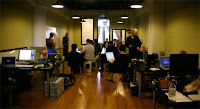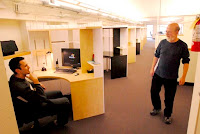 There is a hot and happening trend in knowledge work these days. It seems to have emerged a couple years ago, largely spontaneously, as disaffected technology freelancers got fed up with the isolation of working in their home offices and the turbulent chaos of working in cafes.
There is a hot and happening trend in knowledge work these days. It seems to have emerged a couple years ago, largely spontaneously, as disaffected technology freelancers got fed up with the isolation of working in their home offices and the turbulent chaos of working in cafes.My first inkling of this came when reading a special report in the Economist magazine last April, which discussed the "new nomads" who work wherever they can find signal, whether on their laptop, PDA, smart phones, or blackberries. You see them at Starbucks, the library, and other areas where WiFi is promiscuously available.
On a recent road trip, my GCN colleagues and I sketched out a business plan to create a mental health club for nomadic innovators, a "venture community center" where entrepreneurs could work on their businesses among others of the similar inclinations, with access to GCN's network of domain experts, coaches, investors, etc. When I began to look into it, I discovered we'd reinvented the wheel, albeit a fairly shiny new wheel with a lot of permutations.
The term of art in the movement (it's so embryonic as to hardly constitute an industry -- yet) is "coworking". It manifests in a number of models, but the common features are a community workplace occupied by people working on their own projects, but actively collaborating, brainstorming, and socializing.
One of the godmothers of this movement is Tara Hunt, co-founder of CitizenSpace in San Francisco. I had an opportunity to visit her operation last week, and it was fascinating. For one thing, it was within sight of the location of the first startup I worked for back in the 1980s, Friend Technologies (introducing a service called "voice mail"; you may have heard of it). But the other thing that I found intriguing was that it was largely unoccupied, even though they are sold out. Startling at first, upon reflection I realized it made sense;
 when you're a one-man-band, you're not spending a lot of time at a desk. You're out there, meeting with folks, adding value at client premises, and prospecting for new business. CitizenSpace is an agreeably funky loft space with a dozen desks and an airy conference room. There was indeed a meeting taking place in the conference room, but aside from Tara, there was only one other solitary worker at a desk.
when you're a one-man-band, you're not spending a lot of time at a desk. You're out there, meeting with folks, adding value at client premises, and prospecting for new business. CitizenSpace is an agreeably funky loft space with a dozen desks and an airy conference room. There was indeed a meeting taking place in the conference room, but aside from Tara, there was only one other solitary worker at a desk.CitizenSpace is organized around a co-op model. It's not intended to produce a profit, but rather be a crucible for creative collaboration. The members are all "desk residents"; that is, they have a desk that is theirs alone, and pay a monthly rent for the use of it. While some coworking spaces are similarly aligned, others are more explicitly business models that can produce surplus cashflow, while preserving the core principles of the coworking movement. These include;
- Openness – Willingness to share ideas freely, without license. Open-source brainstorming.
- Collaboration – Creative interaction that promotes innovation and new science.
- Community – Sharing risks and rewards, obligations and opportunities.
- Sustainability – Combining resources so that less is used by more.
- Accessibility – Minimizing barriers.
 resident desks like CitizenSpace, but also ad hoc access to tables, chairs, desks and a wifi network (called "hot desking") for a monthly membership fee, depending on part-time or full-time use.
resident desks like CitizenSpace, but also ad hoc access to tables, chairs, desks and a wifi network (called "hot desking") for a monthly membership fee, depending on part-time or full-time use.It is a very attractive, casual, vaguely hip space, not at all like an "office". There is a conversation pit of black leather sofas and easy chairs. A row of cubicles separated by translucent plastic panels were lined up against one wall, but otherwise it was all very "open plan" cafe style furnishings.
I also visited a launch party in Fresno for OfficeBay, a spinoff of another casual workspace operation called CargoBay, which started up 18 months ago, offering 50 10'x10' hardwall offices with a desk and IP telephone for $399 a month. The play here is that there are also rollup-door storage units, a shipping and receiving dock, and a photo studio (a lot of Ebay auctioneers operating there). The new place has larger offices for up to 6 workers, a cluster of individual cubicle resident desks, and a hot desk area off the main lobby. This is a more overtly commercial work space operation, and not very aligned with the coworking movement, but it is clear that the potential for collaboration and community is there, as well.

From reading the Google coworking group and wiki page, it's clear that coworking is in its infancy, and seems to have the most traction in major urban centers in established technology corridors. In midmarket communities, coworking is primarily following a "jelly" model, which is sort of a flash mob of people who coordinate via twitter or text message to descend on a library community room or cafe to spend the day working together.
I think the coworking model has great potential for incubating emerging growth companies. Existing incubator programs have been problematic, and have largely failed to stimulate interdisciplinary collaboration. I think this is due to the limited number of dedicated office spaces that can be supported in that model.
In a coworking space, significantly higher numbers of companies can be supported, since the resources are randomly deployed as available and as needed. It also provides a venue and audience for guest speakers, panel discussions, workshops, and networking events explicitly focused on entrepreneurship and business development themes. There can be a social dimension as well, such a karaoke or Guitar Hero night.
The connections that can be made in this sort of intentional community can be very immediately valuable, indeed. These are the types of professional relationships colleagues form in large corporate workplaces, and are what freelancers miss the most when they begin working exclusively from home. As in corporate office relationships, these connections can become long-term allegiances, forming a network of like minds. I think successful coworking venues will be the ones that put resources into stimulating and sustaining collegial connections. For the innovator wanting to start and grow a great company, coworking is like a petri dish for ideas.


